Second Warmest February on Record
The statewide average temperature of 38.4°F in February 2024 was 11.7°F above average and made it the second-warmest February on record in Nebraska, cooler only than February 1954 (40.2°F). For the eastern crop reporting districts, it was the warmest February on record, and only the Panhandle was not in the top five warmest. Anomalies were north of 10°F for all crop reporting districts in the state except the Panhandle. Strongest warm anomalies were found in the northeast and east-central crop reporting districts with both checking in at +13.8°F
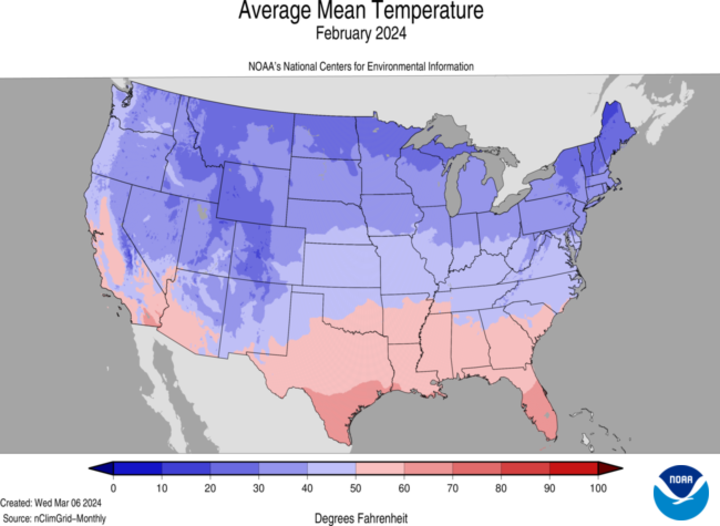
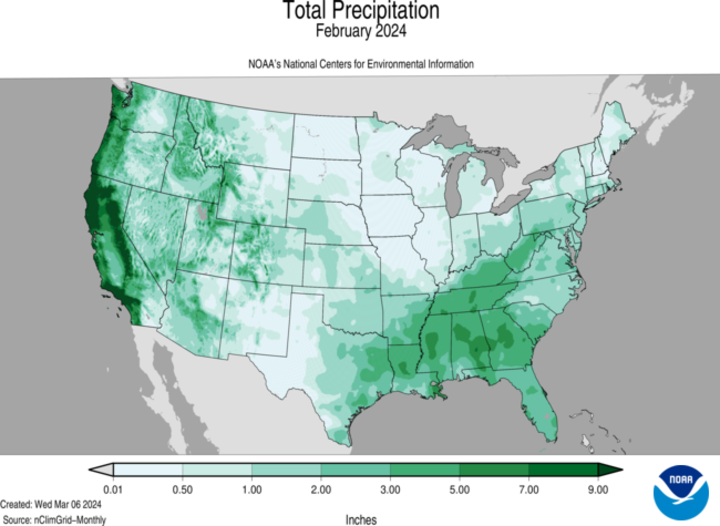


Precipitation Slightly Above Average
The statewide average precipitation was 0.84-inch, 0.18-inch above average. For the Panhandle, the average of 0.97-inch was the 10th wettest on record and precipitation was also above average for the north-central, southwest, south-central, and central crop reporting districts. Precipitation was below average in eastern Nebraska and was particularly below average in northeast Nebraska, where it was the 18th-driest February on record. Most of the precipitation that did occur in the central and eastern sections of the state fell in the first weekend, with heaviest rain totals found over the central section of the state from Broken Bow to Holdrege, where totals over an inch were common.
After the first weekend in February, most of the precipitation in the state occurred in the Panhandle and north-central sections of the state. Much of this was in the form of snow, with stations/observers around Scottsbluff and Alliance reporting 12-plus inches of snow for the month. The moisture in the Panhandle was welcome after a dry January.
Snowfall Inequality
While sections of the Panhandle had over a foot of snow in the month of February, most locations had less than three inches, and several locations along and south of I-80 in central and eastern Nebraska had no measurable snowfall all month. This set or tied record low snowfall for the month of February in those locations with no measurable snowfall.
Warm Temps and Wildfire
While the entire month was well-above average statewide, Feb. 26 deserves the title of a 1980s Bruce Springsteen song as a headline. Rationale: Temperatures hit or exceeded 80°F for the first time in February for much of southeastern Nebraska and were well into the 70s in central and northeastern Nebraska. The warm temperatures were also accompanied by stronger winds and very low humidity. This combined with a high fuel load in dormant vegetation meant that conditions were ripe for wildfires. Unfortunately, there was a large fire in west-central Nebraska in an area known as Betty's Way. Over 70,000 acres burned and took several days to fully contain. No one was injured, but homes and a lot of agricultural infrastructure was destroyed in the fire.
Catch Me I'm Falling
Sticking with music from the ‘80s in this summary, the all-time record temperatures in eastern Nebraska were replaced by a quick blast of winter. Temperature drops between the afternoon of Feb. 26 and 27 were over 40°F statewide and approached or hit drops of 60°F in northeastern Nebraska. For Norfolk, the drop from 75°F to 15°F between the 1556 CST observations on Feb. 26 and 27 was a new all-time temperature drop. For Valentine, the 58°F drop from 68°F to 10°F was good for third place. Temperature drops of 54°F and 53°F in Omaha and Lincoln, respectively, were also good for third place all-time.
Drought Update
There was some improvement early in the month across southern portions of the state, with a slight decrease in the overall percentage of the state in drought (26% vs. 25%) at the end of February compared to the beginning of the month. This continues a positive trend in drought removal that began last spring.

Precipitation Summary by Crop Reporting District
- Panhandle — 0.97-inch (+0.50-inch), 10th wettest
- North-central — 1.05-inch (+0.45-inch)
- Northeast — 0.26-inch (-0.56-inch)
- Central — 0.90-inch (+0.25-inch)
- East-central — 0.41-inch (-0.47-inch)
- Southwest — 1.09 inches (+0.56-inch)
- South-central — 1.12 inches (+0.45-inch)
- Southeast — 0.64-inch (-0.31-inch)
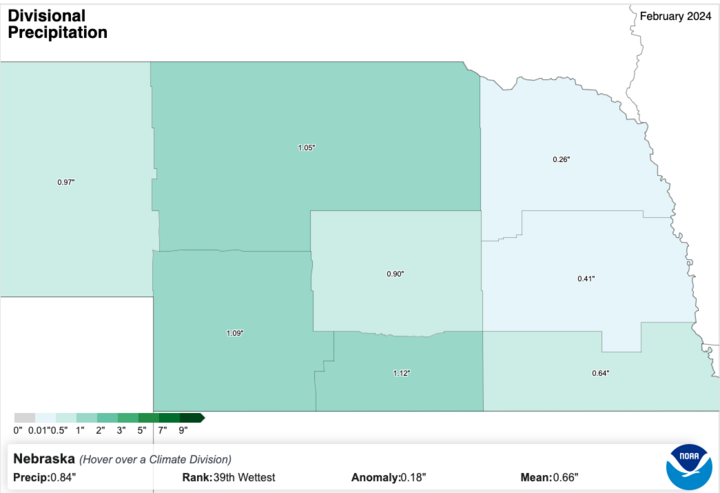
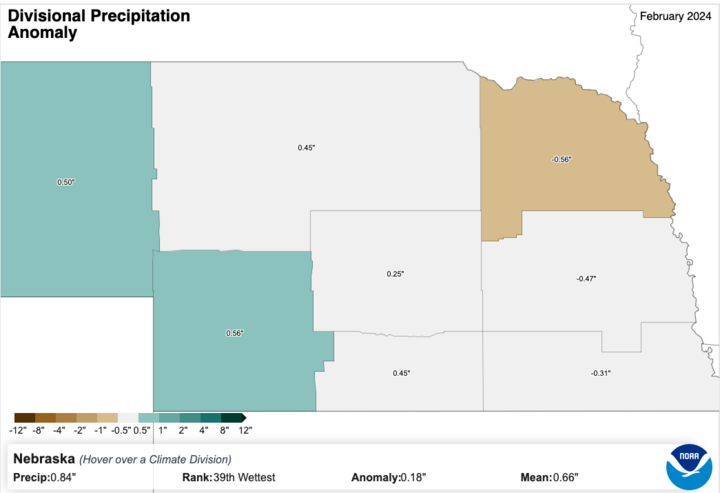
Temperature Summary by Crop Reporting District
- Panhandle — 35.3°F (+8.0°F), sixth warmest
- North Central — 37.6°F (+12.4°F), second warmest
- Northeast — 37.4°F (+13.8°F), warmest
- Central — 39.4°F (+12.8°F), second warmest
- East Central — 40.1°F (+13.8°F), warmest
- Southwest — 39.9°F (+10.5°F), second warmest
- South Central — 41.2°F (+12.1°F), third warmest
- Southeast — 41.7°F (+13.2°F), warmest
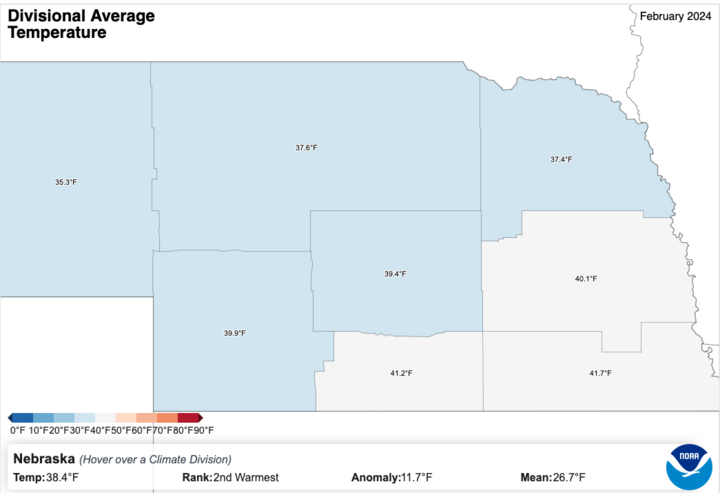

Monthly Max/Min Snowfall, Precipitation, Temperature
- Maximum Snowfall — Bushnell 15S with 14.2 inches
- Maximum Precipitation — Callaway 0.2 S with 2.08 inches
- Maximum Temperature — Falls City Brenner Field FIELD with 82°F
- Minimum Temperature — Agate 3 E with -11°F
